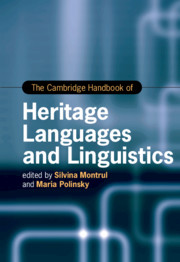Book contents
- The Cambridge Handbook of Heritage Languages and Linguistics
- Cambridge Handbooks In Language And Linguistics
- The Cambridge Handbook of Heritage Languages and Linguistics
- Copyright page
- Dedication
- Contents
- Figures and Tables
- Contributors
- Acknowledgments
- Introduction
- Part I Heritage Languages around the World
- Part II Research Approaches to Heritage Languages
- Part III Grammatical Aspects of Heritage Languages
- Part IV Heritage Language Education
- 29 Elementary School Heritage Language Educational Options and Outcomes
- 30 Community-Organized Heritage Language Programs
- 31 Curricular and Programmatic Language Development Opportunities for University-Level Heritage Language Learners
- 32 Instructed Heritage Language Acquisition
- 33 Issues and Practices in Community-Based Experiential Learning for Heritage Speakers in the United States
- 34 Developing Spanish Heritage Language Biliteracy
- 35 Heritage Language Assessment
- 36 Embracing Opportunity in Heritage Language Revitalization
- 37 Heritage Language Planning and Policy
- Index
- References
33 - Issues and Practices in Community-Based Experiential Learning for Heritage Speakers in the United States
from Part IV - Heritage Language Education
Published online by Cambridge University Press: 04 November 2021
- The Cambridge Handbook of Heritage Languages and Linguistics
- Cambridge Handbooks In Language And Linguistics
- The Cambridge Handbook of Heritage Languages and Linguistics
- Copyright page
- Dedication
- Contents
- Figures and Tables
- Contributors
- Acknowledgments
- Introduction
- Part I Heritage Languages around the World
- Part II Research Approaches to Heritage Languages
- Part III Grammatical Aspects of Heritage Languages
- Part IV Heritage Language Education
- 29 Elementary School Heritage Language Educational Options and Outcomes
- 30 Community-Organized Heritage Language Programs
- 31 Curricular and Programmatic Language Development Opportunities for University-Level Heritage Language Learners
- 32 Instructed Heritage Language Acquisition
- 33 Issues and Practices in Community-Based Experiential Learning for Heritage Speakers in the United States
- 34 Developing Spanish Heritage Language Biliteracy
- 35 Heritage Language Assessment
- 36 Embracing Opportunity in Heritage Language Revitalization
- 37 Heritage Language Planning and Policy
- Index
- References
Summary
A key issue in the field of heritage language education is to ascertain which instructional practices most effectively address heritage language learners’ unique linguistic and socio-affective needs. Previous research on these learners’ profiles has deepened our understanding of the diverse linguistic competencies as well as the cultural backgrounds and experiences that they bring to the classroom. Likewise, recent socioeducational and sociolinguistic scholarship has also underscored the critical roles that identity, attitudes, and motivations play in the development of the heritage language. Combining insights from both research strands, experiential learning/community-based heritage language curricula has recently emerged as an effective pedagogical model that aims to draw on heritage speakers’ knowledge and experiences for the benefit of both the local community and learners. With this in mind, the goal of this chapter is to introduce the reader to the field of community-based experiential learning as it specifically relates to heritage language instructional practices. To this end, we will (i) provide an overview of core topics and relevant research findings, as well as (ii) examine main challenges and opportunities for the field in the years to come.
- Type
- Chapter
- Information
- The Cambridge Handbook of Heritage Languages and Linguistics , pp. 851 - 866Publisher: Cambridge University PressPrint publication year: 2021



